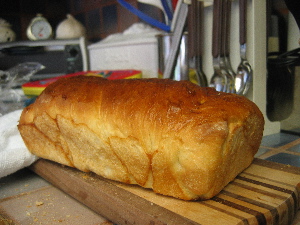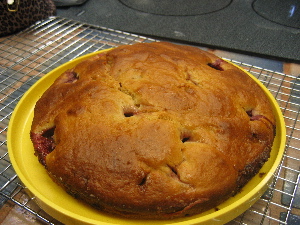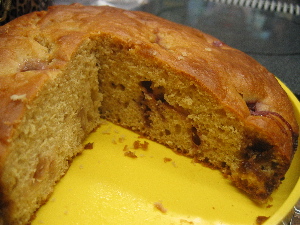On Thursday, home with the kids all day, it was time to make bread again. I’ve made it three times now, each time with a different recipe. I like something about each recipe, although I haven’t been wildly thrilled by any of the bread I’ve made so far. (Although Sophia continously asking for a piece of “the homemade bread” has made me quite proud, let me tell you.)
This time I used Beth Hensperger’s Bread Made Easy. The book has a basic introduction to breadmaking, with what you’re doing for each step and what the bread’s doing during each step. The book contains eight basic recipes with seven or eight variations on each: batter bread, egg bread, white bread, whole wheat bread, holiday sweet bread, flatbread, country bread, and coffee cake.
Here is how my white bread came out:

I like the color on this one, and I like the effect of the eggwash on the top. However…I haven’t had as much luck with breads two and three getting them to rise high enough. This isn’t so much sandwich bread as almost-sandwich bread. I think the problem this time was using 9×5 pans (which Hensperger recommended) instead of 8.5×4.5.
Also, a big problem for me with Hensperger’s books (I also checked out The Bread Lover’s Bread Machine Cookbook ) is that she gives the ingredients by volume instead of weight. I am firmly in the weight-measurements camp—what’s hilarious is, if on the first of this year you’d asked me to describe what in hell the difference was, I’m sure I could have stammered something out, but I wouldn’t have known what I was talking about. But now? Now I am all about the weighing. Especially for a beginner, weighing your ingredients is vital. When I weigh out my flour, I know I’ve got exactly what the recipe calls for. Measuring by volume…maybe I’ve got the right amount of flour, and maybe I’ve compacted a few extra ounces in my cup than the recipe actually needs. No way? Weigh!
§
After dinner I needed to entertain the kids a little, so I said, “Let’s make a cake!” (Yes. I am turning into Weird Mommy. So sue me.) I decided to use Clotilde’s recipe for Yogurt Cake. I asked Sophia if she wanted to put some frozen strawberries in it, and she said yes, and then she asked if she could eat some frozen strawberries…and she now has a new favorite snack. I am hoping to sneak frozen peaches by her in this matter.
The cake is exceptionally easy to make—it’s no wonder kids can help make it: add the ingredients together, stir, stick in pan, cook.
I thought the cake came out quite well:


The strawberries more or less collapsed during the baking, though, leaving strawberry-tasting spots behind: those reddish spots are areas where strawberries used to be. Is there anything I could have done to avoid that? Or is that the cost of using frozen fruit?
The other interesting development was that the brown sugar we used was clumpier than I thought, and no matter how much Sophia stirred it or I attacked it, there were rocks of brown sugar. The finish cake had pockets of melted brown sugar throughout. This did not affect the taste, except for the better.
(My cake came out of its pan with no problem! Several people on Clotilde’s page, including Clotilde, mention having problems getting the cake out!)
Unfortunately the cake finished too late for us to actually eat it, so I put it under foil until the morning, at which point we all had a piece (or possibly two) and declared it the best cake ever, especially since the kids had made it.
§
While I’ve made bread three times—the second time was a recipe from The Bread Baker’s Apprentice by Peter Reinhart and the bread tasted great; it just didn’t rise high enough—I’ve made dough four times. The fourth time was a disaster: I made a starter per Alton Brown’s directions in I’m Just Here For More Food and got down to business making his “Everyday Bread.” I added the ingredients to the bowl and started the machine kneading. It was a wet dough. It was a very wet dough. When I added at least an extra cup of flour and it was still a wet dough, I gave up. Obviously I’d done something horribly wrong.
I need more successes with direct doughs before I can figure out what happened here.
§
My friend Michele asked me, “What’s up with all this baking?” I said, “It’s a way to be creative with the kids around.” I cannot concentrate on my writing when we’re all together, and I’d like to interest them in cooking, if at all possible, since I’ve come to it rather late, myself.
I think I’m also particularly interested in baking (as opposed to cooking in general) because it’s not something Darin knows particularly much about. He’s not interested in baking; he hasn’t read tons and tons of baking-specific cooking books. It’s nice to carve out my own little niche in the kitchen.
Also: excuse to have extremely tasty food around. “I had to bake the cookies! Had to try that recipe!”
§
I am up at this ridiculous hour because I decided to make chicken stock tonight and I have to wait for it to cool down in the cold water bath in the kitchen sink. I have lost my mind. I know this now.
In my quest to be a better baker I too have come across the fruit sinking problem you mention. From what I’ve read it has to do with the batter not being heavy enough to be able to sustain the weight of the fruit. Some things that might help are folding the fruit at the very end before pouring into your pans or adding a little flour to the fruit (I forget why on this one) crushing some of the fruit first somtimes helps. A good website and one that I use often for emergency answers during baking is baking911.com. Your bread and cake looked fantastic. I’ve been curious about that Hensperger book but have refrained from buying it because I now own way too many bread specific baking books.
A few comments:
1) Yum.
2) You say, “When I weigh out my flour, I know I’ve got exactly what the recipe calls for.” You also say when you tried that last bread recipe, you ended up w/ wet dough even after you’d added a cup of flour. Here’s the thing: with breadmaking, you really can’t follow any kind of exact recipe. Well, sure, you should add X amt of yeast and Y amt of salt, but flour and water (or milk) should really be eyeballed. So if the dough was wet after an extra cup of flour, add yet another. And yet another. And so on, until it achieves the right consistency. Don’t be afraid to stray from the book. Dough is a living thing and a book will never be able to account for variations. (It matters more w/ cakes and such, but even there you have more room for trial and error — remember my butter disaster w/ the New Year’s scones? Worked out fine.)
3) I suspect you’re right about the too-large pans, but another possible culprit is the yeast. You might want to try different brands. Also, try letting the final rising go longer. To my eye, the breads you’ve pictured look a little under-risen.
4) I just stick the strained chicken stock in the fridge overnight (or longer). The fat rises to the top and solidifies nicely for skimming.
5) I think it’s a wonderful thing to share with your kids!
Deb:
I didn’t actually have a problem with the fruit sinking (although I understand that you must dust your fruit with flour to prevent this in stuff like muffins). If you look at the third picture up there, the picture of the cake with the piece(s) cut out, you can see there are spots in the middle of the cake where the strawberries were. I had put half the batter in, then the strawberries, then the rest of the batter in, the way Clotilde says, and it seemed to work great…except for the strawberries vanishing! It’s some kind of magic trick.
Tamar:
2) The problem with the starter dough I made from Alton’s recipe is that after adding a whole bunch of flour, it was still the consistency of cake batter, nowhere near bread dough that’s just on the wet, sticky side. Maybe that’s how it’s supposed to be after a whole bunch of flour, but I didn’t think so! If it was supposed to be that wet, I would have expected some sort of note in the text, but I didn’t see anything. Again, this is probably the sort of thing that gets easier to deal with after a while, but you know: four batches of bread dough so far.
3) The yeast itself is fine: my friend Laura even tested it in warm water with some sugar today. Foaming occurred. Probably more a problem with underrising.
4) Alton (yeah, him again) is the reason I *didn’t* use my fridge: he points out that if you put a giant pot of hot stock in your fridge, what you get is a warm fridge (during the crucial temperatures when you’re trying to avoid bacterial growth).
Also, since our refrigerator is small, it’s easier to cool the stock down in a hurry in an ice water bath in our sink and then decant into the smaller, easier-to-store storage bottles for the refrigerator.